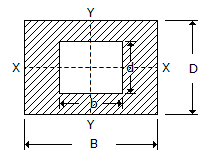Test: Engineering Mechanics - 8 - Mechanical Engineering MCQ
25 Questions MCQ Test - Test: Engineering Mechanics - 8
The maximum velocity of a particle moving with simple harmonic motion is
The loss of kinetic energy due to direct impact of two bodies __________ upon the value of coefficient of restitution.
A body of mass m moving with a constant velocity v strikes another body of same mass m moving with same velocity but in opposite direction. The common velocity of both the bodies after collision is
Moment of inertia of a rectangular section having width (b) and depth (d) about an axis passing through its C.G. and parallel to the width (b), is
According to parallel axis theorem, the moment of inertia of a section about an axis parallel to the axis through centre of gravity (i.e. IP) is given by(where, A = Area of the section, IG = Moment of inertia of the section about an axis passing through its C.G., and h = Distance between C.G. and the parallel axis.)
The resultant of two equal forces P making an angle θ, is given by
The force, by which the body is attracted, towards the centre of the earth, is called
The power developed by a body acted upon by a torque T newton metre (N - m) and revolving at ω radian/s is given by
The time taken by a particle for one complete oscillation is known as periodic time.
The velocity ratio of a first system of pulleys with 4 pulleys is
The moment of inertia of a sphere of mass m and radius r, about an axis tangential to it, is
The velocity ratio for the first system of pulleys is(where n is the number of pulleys.)
The ideal angle of banking provided on the curves on roads depends upon
If a pendulum is taken 1 km below the earth surface in a mine, it will __________ in time.
The moment of inertia of a thin disc of mass m and radius r, about an axis through its centre of gravity and perpendicular to the plane of the disc is
The linear velocity of a body rotating at ω rad / s along a circular path of radius r is given by
A machine which is capable of doing work in the reversed direction, after the effort is removed, is called a non-reversible machine.
The forces which do not meet at one point and their lines of action do not lie on the same plane are known as
A non-reversible machine is also called a self-locking machine.
Mass moment of inertia of a thin rod about its one end is __________ the mass moment of inertia of the same rod about its mid-point
Moment of inertia of a hollow rectangular section as shown in the below figure about Y-Y axis, is not the same as that about X-X axis. 
The angle of the inclined plane at which a body just begins to slide down the plane, is called helix angle.














